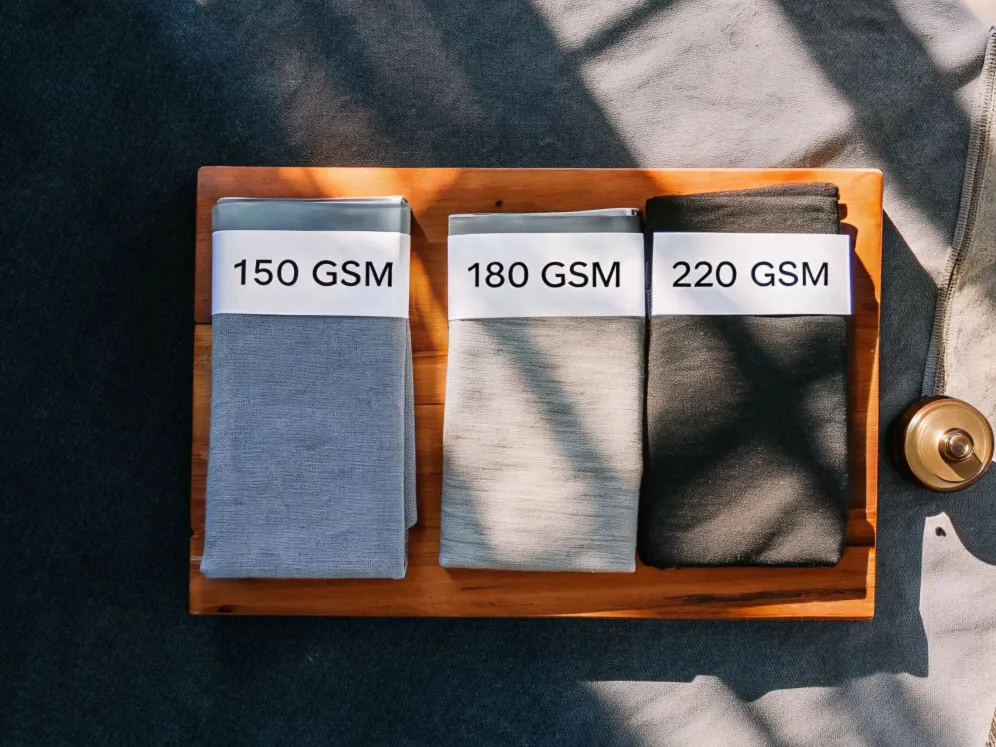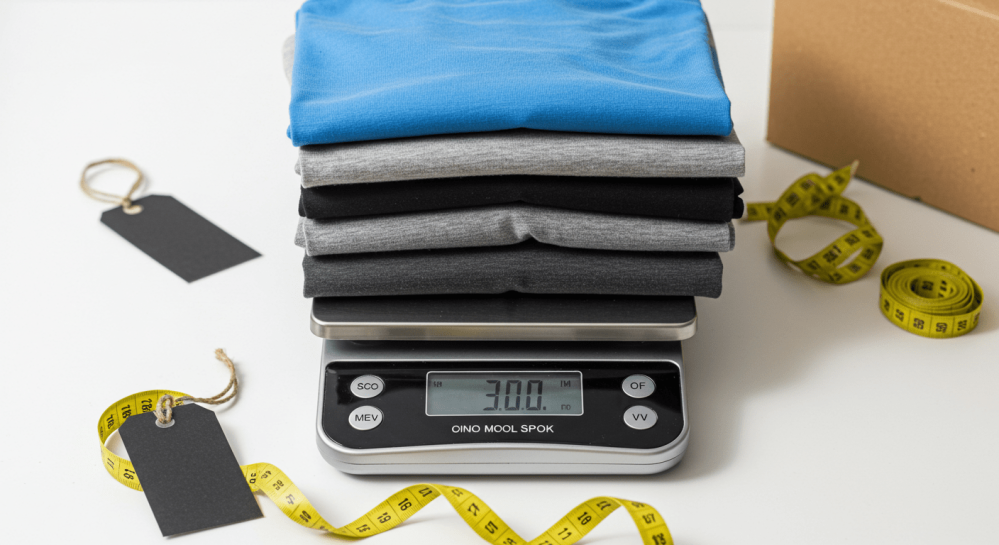How much does a t-shirt weigh ?We need to talk about t-shirt weight. While it doesn’t seem like the flashiest topic, it’s vital to the quality of your custom products. The weight of your tee influences various factors, from the feel and fit to the durability and print results. Think of t-shirt weight as the secret sauce of clothing design.
Dive with us into the realm of t-shirt weights, from lighter tees like a gentle summer breeze on your skin to hefty ones that give you that cozy, snug feeling. We will help you figure out which weight is the perfect match for your vision and customer needs.
How much does an average t-shirt weigh?
The weight of a t-shirt can vary significantly depending on the material, size, and thickness of the fabric. However, as a general rule, a medium-sized t-shirt made from a standard cotton fabric weighs around 4.5 to 5.5 ounces (roughly 130–155 grams). Fabric weight is typically measured in ounces per square yard or grams per square meter (GSM).

How is t-shirt fabric weight measured?
T-shirt weight is typically measured using one of three methods:
- Grams per square meter (GSM)
- Ounces per square yard (oz/yd²)
- Count known as “singles”
Let’s break them all down.
1. Grams per square meter (GSM)
What is GSM?
GSM(grams per square meter) is a standard unit of measure used in the textile industry to determine the weight of the fabric. It tells you how much a square meter of a particular fabric weighs, considering its thickness and density.This is an essential factor in understanding textile quality.
Apparel manufacturers & designers use the GSM metric to assess the thickness and density of textiles.
- A high GSM indicates a denser, heavier, and generally more durable fabric.
- A low GSM suggests a lighter, less dense fabric, more breathable material.
But note that a higher or lower GSM isn’t inherently better or worse—it depends on what you want from the material.
Industry Classification by GSM Range
Fabric weight is categorized into general ranges to guide production:
- Lower GSM (120–140) : Lighter, thinner fabric. Ideal for summer or activewear. (e.g., summer wear, layering T-shirts)
- Mid GSM (150–180) : Standard T-shirt weight. Common for standard casual T-shirts.
- Higher GSM (180–220+) : Thicker, more durable fabric. Preferred for premium or structured fits. (e.g., premium or structured tees)
If you want to compare specific GSMs or understand which GSM is best for different markets or climates.
Please contact me.
Why GSM Matters
GSM affects comfort, durability, drape, and printing suitability. For example, heavier fabrics support high-density prints better, while lighter fabrics enhance breathability and softness. Apparel manufacturers rely on GSM to maintain consistency in quality and performance.

2. Ounces per square yard (oz/yd²)
This is the imperial equivalent of GSM. It refers to the weight of the fabric in ounces per square yard. Again, a higher value indicates a heavier, denser fabric. A typical t-shirt is around 4–7 oz/yd².
3. Singles (Thread Count)
Unlike the two measurements above, singles are measured by counting the yarn, or more specifically, the number of times the yarn is twisted.
The term “singles” refers to the yarn count, a measure of the fineness or coarseness of the fabric. The thread count is determined by the number of times the yarn is twisted, which affects the fabric’s weight, texture, strength, and drape.
- A higher singles count indicates a finer fabric, which is often softer, smoother, and lighter.
- A lower singles count means a coarser and heavier fabric.
Even though this measurement doesn’t directly reflect the weight of a material, it somewhat reflects the nature of the fabric. So when choosing the material for your T-shirt product, you should take this measurement into consideration, in addition to the GSM or oz/yd2.
Conclusion
Each of these measurements can help determine the quality, durability, and feel of a t-shirt. However, it’s important to note that a higher GSM or oz/yd², or a higher or lower singles count, doesn’t automatically mean better quality. The right t-shirt weight and thread count depend on other factors like the intended use of the t-shirt, personal preferences, and specific design requirements.

Why T-Shirt Weight Matters?
Fabric Weight Influences Comfort and Functionality
The weight of a T-shirt, typically measured in GSM (grams per square meter), directly affects how it feels and performs. Lightweight T-shirts (120–150 GSM) offer better breathability and flexibility, making them ideal for warm weather, layering, or casual wear. In contrast, heavier T-shirts (180+ GSM) provide more structure, warmth, and durability, often preferred for cooler climates or workwear.
Perception of Quality and Brand Positioning
T-shirt weight plays a significant role in how consumers perceive quality. Heavier garments often feel more substantial and premium, aligning well with luxury or streetwear brands. Lightweight tees, while more economical, can be seen as disposable if not well-constructed. Brands must strategically select fabric weight to match their target audience and price point.
Printing and Decoration Suitability
The weight of a T-shirt affects its compatibility with printing techniques. Heavier fabrics offer a more stable base for screen printing, embroidery, or other embellishments. Lightweight T-shirts, while suitable for basic prints, may not hold up well to heavy inks or complex artwork.
Durability and Longevity
Heavier T-shirts typically use denser yarns and tighter weaves, making them more resistant to pilling, stretching, and general wear. Conversely, lightweight T-shirts may show wear faster, especially if used as promotional items or giveaways.
Shipping and Inventory Cost Considerations
In the world of apparel manufacturing and e-commerce, T-shirt weight affects logistics, packaging, and shipping costs. Lighter T-shirts can reduce shipping costs, especially in the case of bulk T-shirt orders or international shipments. Heavier garments may increase perceived value but incur higher shipping costs.
What is the best weight for t-shirt?
Identifying the ideal weight for T-shirts is a key consideration for anyone in the print-on-demand business, as it affects not only the comfort and durability of the garment but also its suitability for various uses and climates. The best weight for a T-shirt can vary depending on its intended use, target market, and printing requirements. Understanding these variations can help entrepreneurs and designers select the best options for their specific needs.
- Lightweight T-Shirts (3.5 to 4.3 ounces)
Preferred for hot weather or athletic wear due to their breathability
Suitable for layering without adding bulk - Midweight T-Shirts (4.5 to 5.5 ounces)
Ideal for everyday wear, providing a balance of comfort and durability
Versatile for both casual and promotional use - Heavyweight T-Shirts (6 ounces and up)
Best for cooler climates or as workwear due to their thickness and durability
Offers a premium feel, ideal for high-quality branding
Choosing the right T-shirt weight involves considering the garment’s purpose, the preferences of the target audience, and the specifics of the design to be printed.
Best Weights by Purpose:
- For Fashion Brands
150–180 gsm — Soft feel, good drape, holds print well. - For Promotional Tees
135–160 gsm — Budget-friendly, lightweight. - For Premium Streetwear or Heavy-Duty Use
180–220+ gsm — Heavier, boxier cut, high-end feel. - For Activewear
Lightweight polyester blends, often under 160 gsm — breathability over bulk.
By selecting the appropriate weight, print-on-demand businesses can ensure their products meet the expectations of their customers and stand out in the competitive market.

How to tell if a shirt is heavyweight?
To judge whether a T-shirt is thick or not, you can start from the following aspects:
Check the product label
The label usually indicates the fabric composition, weight and other information. Weight refers to the weight of the fabric per square meter, usually expressed in Gsm.
Observe the texture of the fabric
If the texture of the fabric is dense and thick, with small gaps between the fibers, then the T-shirt may be thick and heavy. On the contrary, if the texture of the fabric is sparse and thin, with large gaps between the fibers, it is usually thin and light.
Touch it with your hands
Touch the T-shirt with your hands to feel its weight and texture. A heavy T-shirt will feel heavy and solid in your hands. A thin T-shirt will feel light and soft and delicate. At the same time, you can also gently pull the fabric to observe its elasticity and thickness changes.
Try it on to feel
Try it on is the most direct way to judge whether a T-shirt is thick or not. After putting it on, feel the weight and pressure of the T-shirt against your body, and whether it feels restrictive or stuffy when you move.
How much does a cotton t shirt weigh?
As a professional clothing manufacturer.
The following is a systematic analysis of the weight of cotton T-shirts:
- Standard Weight Range
A typical cotton T-shirt weighs between 120g and 220g (4.2 to 7.8 oz). This range depends on the fabric weight (GSM), size, cut style, and additional design. - Size & Construction
T-shirts of the same fabric weight can weigh significantly different sizes. For example, a medium size may weigh 160g. An XL size may weigh over 190g. - Yarn Type & Cotton Quality
Different types of cotton (e.g., combed, organic, ring-spun) and spinning techniques (e.g., single 30s, double 40s) also affect the weight of a T-shirt. T-shirts made from high-count double yarns are thinner and smoother, while coarse single yarns are more durable but slightly heavier. - Use Case Drives Fabric Weight
Fitness T-shirts or workwear products prefer heavier fabrics for increased durability and coverage. Fast fashion brands or sportswear tend to prefer lightweight designs to save costs and facilitate transportation.
How much does the average XL t-shirt weigh?
An average XL T-shirt typically weighs between 180 to 250 grams (6.3 to 8.8 ounces). The exact weight depends on fabric type, GSM (grams per square meter), and specific design features.
The GSM rating of the fabric plays a critical role.
- A lightweight XL T-shirt (140–150 GSM) may weigh approximately 180–200 grams.
- A midweight XL T-shirt (160–180 GSM) generally weighs around 200–230 grams.
- A heavyweight XL T-shirt (200+ GSM) can exceed 240 grams, especially when made from dense cotton or blended knits.
Fabric composition is also important. 100% cotton is denser and heavier than polyester or performance blends. Specialty fabrics (like combed cotton or slub yarn) may also shift the weight slightly upward.
Design and Construction
- Sleeve length: Long-sleeve XL T-shirts add 30–50 grams more than short sleeves.
- Cut and fit: Oversized or relaxed-fit styles use more fabric and weigh more than slim-fit versions.
- Additional features: Ribbed collars, double stitching, or added trims may slightly increase total weight.
In summary, a standard XL T-shirt made of midweight cotton (about 160–180 GSM) typically weighs around 200–220 grams. For shipping, inventory planning, or product development, brands often round this figure to 210–230 grams as a safe average.

How to Choose the Right T-Shirt Weight for Your Project?
Selecting the appropriate T-shirt weight for your project is crucial for ensuring the final product meets your expectations in terms of quality, durability, and comfort. Whether you’re an entrepreneur, a designer, or a business owner in the print-on-demand industry, understanding how to choose the right T-shirt weight can significantly impact your brand’s success and customer satisfaction.
- Identify the Purpose of the T-Shirt
Determine whether the T-shirt will be used for casual wear, athletic purposes, promotional events, or as workwear. Different uses, use different weights of materials. - Consider your target audience
Consider the preferences and needs of consumers. Consider factors such as climate, activity level, and fashion trends. Choose a weight that is right for them. - Evaluate the Printing Method
Different printing techniques may work better with certain fabric weights. For example, heavier weights might be more suitable for high-quality screen printing, while lighter weights could be better for direct-to-garment printing. - Factor in Seasonality
Heavier fabrics might be more appropriate for cooler seasons, while lighter weights are ideal for summer or warmer climates. - Balance Quality and Cost
Higher fabric weights often indicate better quality and durability. But also come with a higher price tag. Consider your budget and how the T-shirt’s weight will affect the overall cost.
Consider these factors carefully. Choose a T-shirt weight that matches your project goals. Satisfy your customers and enhance the overall value of your product and brand.
If you are looking for a clothing manufacturer. Sumkclothing is your ideal choice. With rich experience in clothing, we can help you solve all problems.
Summary
Remember, there’s no right or wrong answer when choosing your t-shirt’s weight. It’s all about what fits best for your design vision, your customers’ preferences, and the statement you want your brand to make.
So, apply this knowledge to your next design project and feel the difference it makes. Here’s to creating fantastic products that look great and feel amazing to wear. Happy designing and even happier selling!



